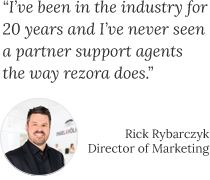Branding To Sell Homes
.png?width=300&name=Copy%20of%20F4b_ProductiveandFree%20(2).png)
Consistent presentation of a brand has been seen to increase revenue by over 30%.
What is a Design System?
A design system is a single source of truth which groups all the elements that will allow teams to design, realize, and develop a product. While there are a myriad of benefits, here are a few...
- Streamline efforts and avoid repetition of menial tasks by reusing components of your Design System, while keeping best practices top of mind.
- Resolve design and tech debt even quicker with a reusable framework in place.
- Communicate your expectations as clearly as possible, with tangible guidelines available via your Design System.
- Provide processes and back-up as team members change.

Fun Fact: 99% of consumers reported that they check their email every day and it's their preferred way to receive updates from brands. Best make those some good emails!
Sneak peek inside...
Chapter One: Getting Started
As a real estate agent or marketer, you want to get as many eyes on your listings as possible. To effectively get eyes on your listings, you should have a marketing strategy in place, and that strategy should prioritize some sort of email marketing. In this day and age, it’s no secret that digital efforts are the most effective, with 99% of consumers reporting that they check their email every day and it’s their preferred way to receive updates from brands1. Plus, the real estate market is beginning to skew towards millennials, with their generation making up 37% of 2019’s home buyers2. It should come as no surprise that millennials prefer technology and are incredibly tech savvy, so how are you staying on top of your digital strategy to position yourself accordingly as millennials (and Gen Z’s!) continue to take over the homebuyer market?
One easy way to appeal to your audience and the ever-evolving millennial audience is to tighten up your brand standards. Not only has consistent presentation of a brand been seen to increase revenue by over 30%3, but it’s a way to cultivate trust within your audience. Consumers want to know who they’re supporting, and creating a consistent voice across your marketing gives your potential client the impression that you’re organized; plus you sticking to your messaging is a simple way to position yourself as a consistent and trustworthy agent or brokerage to work with (and then work with again!).
81% of consumers reported that they need to be able to trust the brand before buying from or working with them.
How many times have you gone to create a marketing piece and then realized that you don’t know the hex # of the color that your coworker previously used on a button? You send them a quick message, but now you’re stuck waiting for their response before you can finish your piece. Or, you can pick something that’s close enough, but then you’re headed down a dangerous road where you’ll never really have solid brand standards, just loose ideas floating around the office.
Enter a Design System. A Design System is a single source of truth which groups all the elements that will allow teams to design, realize and develop a product5. Beyond ensuring brand compliance, a Design System can alleviate a myriad of problems:
- Help everyone involved understand why decisions were made, while also being required to ultimately make less decisions, with a single source being the most updated and accurate resource.
- Streamline efforts and avoid repetition of menial tasks by reusing components of your Design System, while keeping best practices top of mind.
- Resolve design and tech debt even quicker with a reusable framework in place.
- Communicate your expectations as clearly as possible, with tangible guidelines available via your Design System.
- Provide processes and back-up as team members change.
A Design System has an abundance of benefits, but where do you start? In this eBook, we’ll walk you through the things your Design System should include, things to consider while putting it together, where it should be housed, and how to deploy your completed Design System. So, let’s get started!
Chapter Two: Branding
When you start any new project, the smartest thing you can do is make sure you know exactly why you’re doing it and what a successful outcome looks like. This is where we recommend creating a few SMART goals. What is a SMART goal?
.png?width=500&name=Untitled%20design%20(10).png)
SMART goals are meant to support your overarching business goals, so make sure you have those laid out first. Common business goals look like increased lead generation, increased brand awareness, or increased traffic to your website.
Using a signature color can increase brand recognition by 80%.
Maybe you want to improve the quality of your branding and the consistency with which you’re able to release marketing pieces. A SMART goal for these particular milestones could look like this:
- Create two on-brand sales collateral one-pagers
- Send three targeted, on-brand newsletters per month
- Post on each social media platform with on-brand graphics at least every other day
Now, when you look back at your Design System, you’ll remember where you were before it was implemented and be able to see tangible results. These can be quarterly goals, yearly goals, or maybe even just a weekly goal, but being able to check those boxes at the end of it will feel great (and keep you motivated to continue using your Design System!).
Once you have your goals in place, it’s time to think about the “why?”. Why are you taking the time to organize and streamline your design assets? How will it help you and your business and it’s marketing goals? Who is going to be using it? These are tough questions to answer yourself if you work on a team, so don’t be afraid to collaborate. Find out what your peers are looking to accomplish or what their particular pain points are and how your Design System can alleviate them. After all, how are you going to get the results you want if you don’t know what exactly it is that you want? And how are you going to convince the rest of your team to use the System consistently if it’s not answering to their needs as well? This is the time to get your ducks in a row so your hard work won’t go to waste.
Your end goals that you’ve taken the time to come up with aren’t just going to help you develop new assets and a new Design System - they’re also going to be your guiding light as you Marie Kondo your existing assets. However, instead of asking yourself if your current email newsletter design brings you joy, ask if it’s helping you reach your aforementioned goals. How well do the components of the design express your brand? Are you completely happy with that logo choice and that button color being used in additional marketing? Is the font choice consistent not only in this email design, but among others? This is where you’ll start to uncover assets that need to be created or tightened up, and this seemingly overwhelming project will start to expose its’ to do list itself.
If you’re looking for a place to start, we recommend whatever software you’re currently using for an email marketing platform. Ideally, you’ll be able to go in and take screenshots of existing email templates for reference, and from there, be able to pick and choose which pieces of that email get to stay, and which are on the chopping block. As you look at each of these pieces, determine a way to measure quality. This is, again, where your goals can come in. For example, if a business goal is to increase website traffic, you’ll want to opt for a CTA button color that’s bright and attention grabbing - likely not the same color that you use for headlines. Or, if your business goal is geared towards brand awareness, you can keep that CTA button color the same, as using a signature color can increase brand recognition by 80%.6

